Analysing Supply Chain Management: Strategies and Globalisation
VerifiedAdded on 2023/04/20
|5
|1039
|80
Essay
AI Summary
This essay delves into various aspects of supply chain management, starting with an analysis of Zara's strategic and operational planning decisions, emphasising small lot production, centralised design, and in-house production. It then contrasts this with Dell's push-pull supply chain strategy, highlighting custom-made goods and minimal inventory. The essay further discusses the importance of balancing responsiveness and efficiency in the context of globalisation, using McDonald's as an example of effective online ordering and distribution. It also examines Amazon's evolution in warehouse strategy, from having no warehouses to adopting a few warehouses strategy to improve customer satisfaction and sales. Finally, the essay touches on sourcing strategies, recommending demand-driven models for office supplies and in-house production for electronic components to enhance responsiveness and meet business objectives. Desklib offers a range of resources, including past papers and solved assignments, to aid students in understanding these complex concepts.
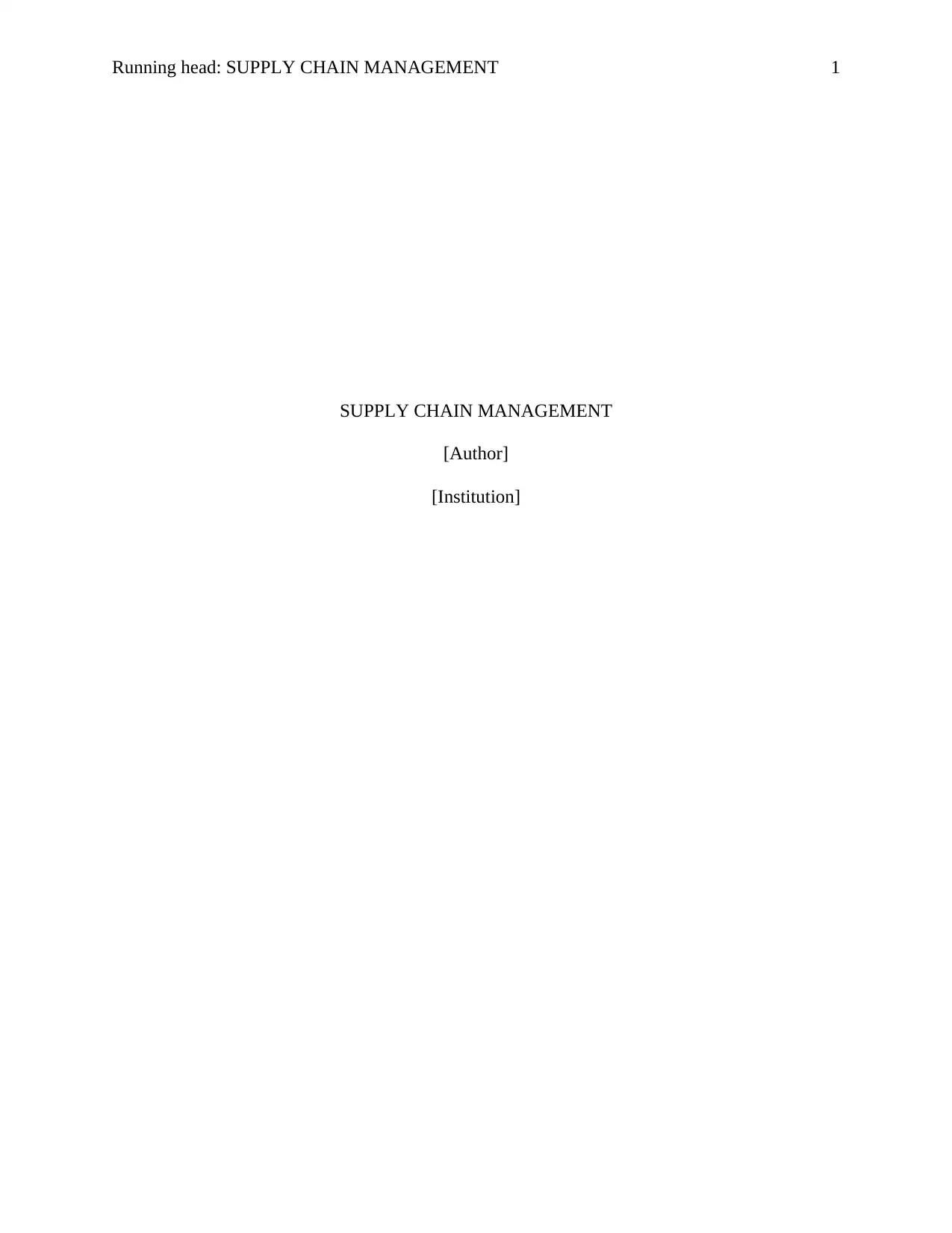
Running head: SUPPLY CHAIN MANAGEMENT 1
SUPPLY CHAIN MANAGEMENT
[Author]
[Institution]
SUPPLY CHAIN MANAGEMENT
[Author]
[Institution]
Paraphrase This Document
Need a fresh take? Get an instant paraphrase of this document with our AI Paraphraser
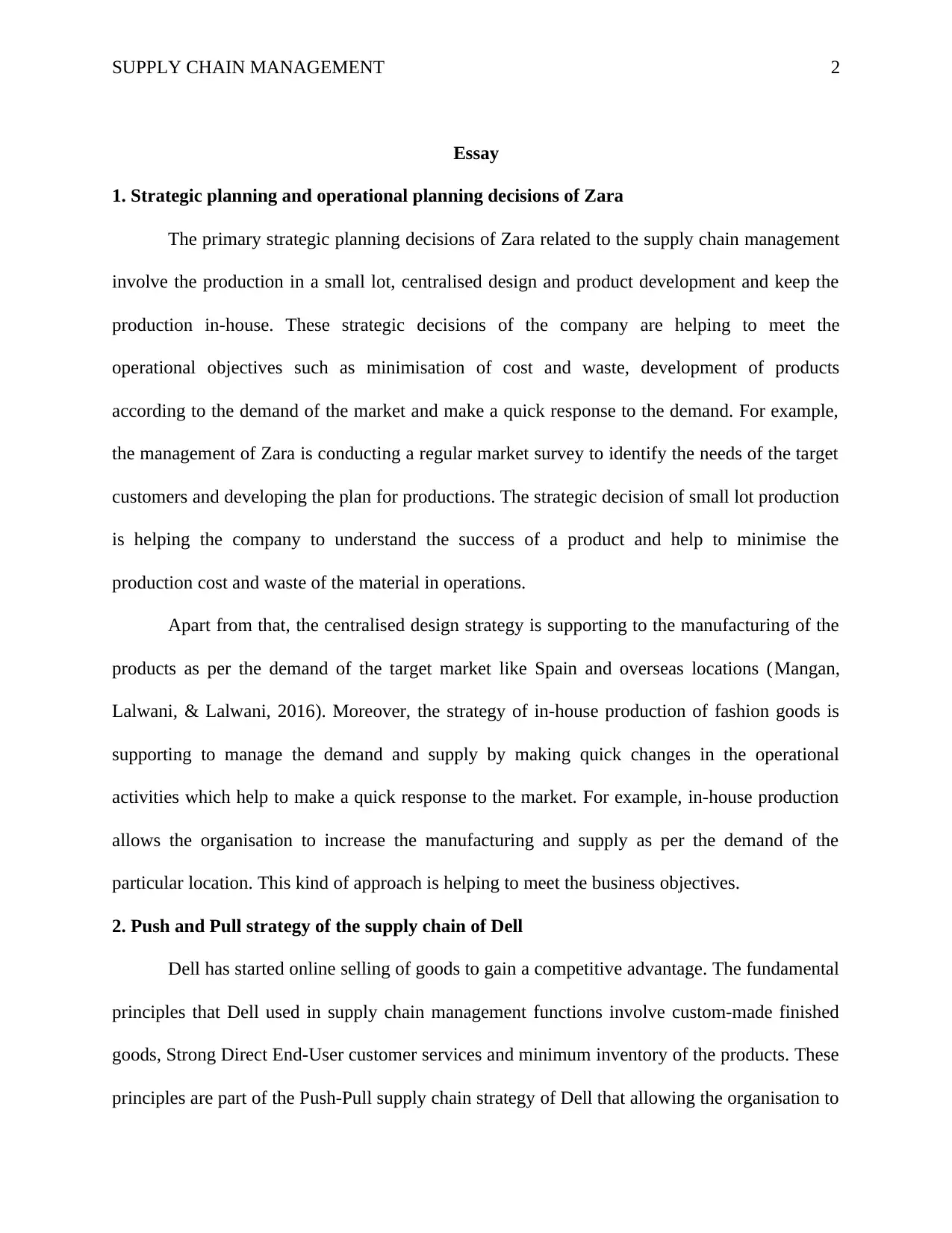
SUPPLY CHAIN MANAGEMENT 2
Essay
1. Strategic planning and operational planning decisions of Zara
The primary strategic planning decisions of Zara related to the supply chain management
involve the production in a small lot, centralised design and product development and keep the
production in-house. These strategic decisions of the company are helping to meet the
operational objectives such as minimisation of cost and waste, development of products
according to the demand of the market and make a quick response to the demand. For example,
the management of Zara is conducting a regular market survey to identify the needs of the target
customers and developing the plan for productions. The strategic decision of small lot production
is helping the company to understand the success of a product and help to minimise the
production cost and waste of the material in operations.
Apart from that, the centralised design strategy is supporting to the manufacturing of the
products as per the demand of the target market like Spain and overseas locations (Mangan,
Lalwani, & Lalwani, 2016). Moreover, the strategy of in-house production of fashion goods is
supporting to manage the demand and supply by making quick changes in the operational
activities which help to make a quick response to the market. For example, in-house production
allows the organisation to increase the manufacturing and supply as per the demand of the
particular location. This kind of approach is helping to meet the business objectives.
2. Push and Pull strategy of the supply chain of Dell
Dell has started online selling of goods to gain a competitive advantage. The fundamental
principles that Dell used in supply chain management functions involve custom-made finished
goods, Strong Direct End-User customer services and minimum inventory of the products. These
principles are part of the Push-Pull supply chain strategy of Dell that allowing the organisation to
Essay
1. Strategic planning and operational planning decisions of Zara
The primary strategic planning decisions of Zara related to the supply chain management
involve the production in a small lot, centralised design and product development and keep the
production in-house. These strategic decisions of the company are helping to meet the
operational objectives such as minimisation of cost and waste, development of products
according to the demand of the market and make a quick response to the demand. For example,
the management of Zara is conducting a regular market survey to identify the needs of the target
customers and developing the plan for productions. The strategic decision of small lot production
is helping the company to understand the success of a product and help to minimise the
production cost and waste of the material in operations.
Apart from that, the centralised design strategy is supporting to the manufacturing of the
products as per the demand of the target market like Spain and overseas locations (Mangan,
Lalwani, & Lalwani, 2016). Moreover, the strategy of in-house production of fashion goods is
supporting to manage the demand and supply by making quick changes in the operational
activities which help to make a quick response to the market. For example, in-house production
allows the organisation to increase the manufacturing and supply as per the demand of the
particular location. This kind of approach is helping to meet the business objectives.
2. Push and Pull strategy of the supply chain of Dell
Dell has started online selling of goods to gain a competitive advantage. The fundamental
principles that Dell used in supply chain management functions involve custom-made finished
goods, Strong Direct End-User customer services and minimum inventory of the products. These
principles are part of the Push-Pull supply chain strategy of Dell that allowing the organisation to
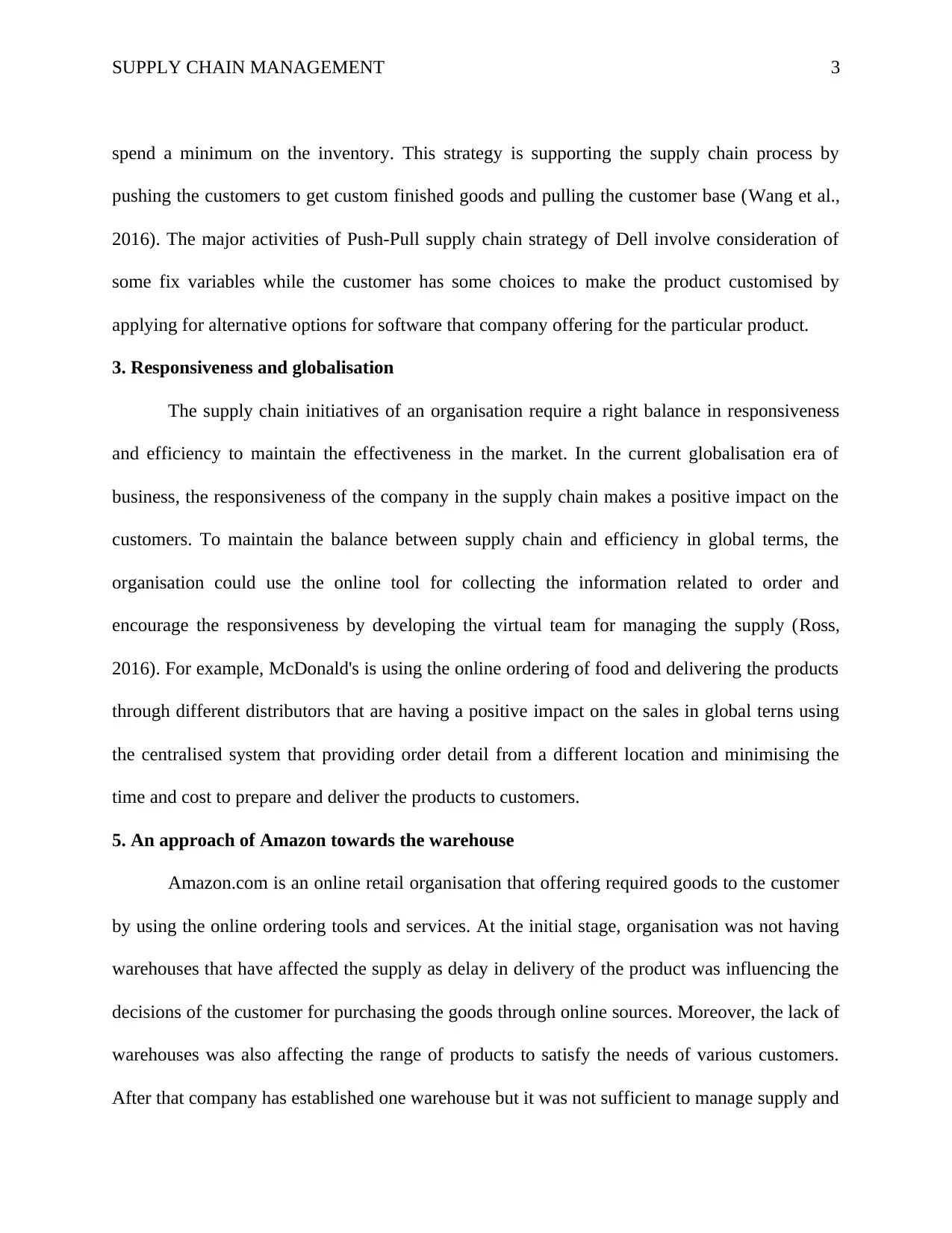
SUPPLY CHAIN MANAGEMENT 3
spend a minimum on the inventory. This strategy is supporting the supply chain process by
pushing the customers to get custom finished goods and pulling the customer base (Wang et al.,
2016). The major activities of Push-Pull supply chain strategy of Dell involve consideration of
some fix variables while the customer has some choices to make the product customised by
applying for alternative options for software that company offering for the particular product.
3. Responsiveness and globalisation
The supply chain initiatives of an organisation require a right balance in responsiveness
and efficiency to maintain the effectiveness in the market. In the current globalisation era of
business, the responsiveness of the company in the supply chain makes a positive impact on the
customers. To maintain the balance between supply chain and efficiency in global terms, the
organisation could use the online tool for collecting the information related to order and
encourage the responsiveness by developing the virtual team for managing the supply (Ross,
2016). For example, McDonald's is using the online ordering of food and delivering the products
through different distributors that are having a positive impact on the sales in global terns using
the centralised system that providing order detail from a different location and minimising the
time and cost to prepare and deliver the products to customers.
5. An approach of Amazon towards the warehouse
Amazon.com is an online retail organisation that offering required goods to the customer
by using the online ordering tools and services. At the initial stage, organisation was not having
warehouses that have affected the supply as delay in delivery of the product was influencing the
decisions of the customer for purchasing the goods through online sources. Moreover, the lack of
warehouses was also affecting the range of products to satisfy the needs of various customers.
After that company has established one warehouse but it was not sufficient to manage supply and
spend a minimum on the inventory. This strategy is supporting the supply chain process by
pushing the customers to get custom finished goods and pulling the customer base (Wang et al.,
2016). The major activities of Push-Pull supply chain strategy of Dell involve consideration of
some fix variables while the customer has some choices to make the product customised by
applying for alternative options for software that company offering for the particular product.
3. Responsiveness and globalisation
The supply chain initiatives of an organisation require a right balance in responsiveness
and efficiency to maintain the effectiveness in the market. In the current globalisation era of
business, the responsiveness of the company in the supply chain makes a positive impact on the
customers. To maintain the balance between supply chain and efficiency in global terms, the
organisation could use the online tool for collecting the information related to order and
encourage the responsiveness by developing the virtual team for managing the supply (Ross,
2016). For example, McDonald's is using the online ordering of food and delivering the products
through different distributors that are having a positive impact on the sales in global terns using
the centralised system that providing order detail from a different location and minimising the
time and cost to prepare and deliver the products to customers.
5. An approach of Amazon towards the warehouse
Amazon.com is an online retail organisation that offering required goods to the customer
by using the online ordering tools and services. At the initial stage, organisation was not having
warehouses that have affected the supply as delay in delivery of the product was influencing the
decisions of the customer for purchasing the goods through online sources. Moreover, the lack of
warehouses was also affecting the range of products to satisfy the needs of various customers.
After that company has established one warehouse but it was not sufficient to manage supply and
⊘ This is a preview!⊘
Do you want full access?
Subscribe today to unlock all pages.

Trusted by 1+ million students worldwide
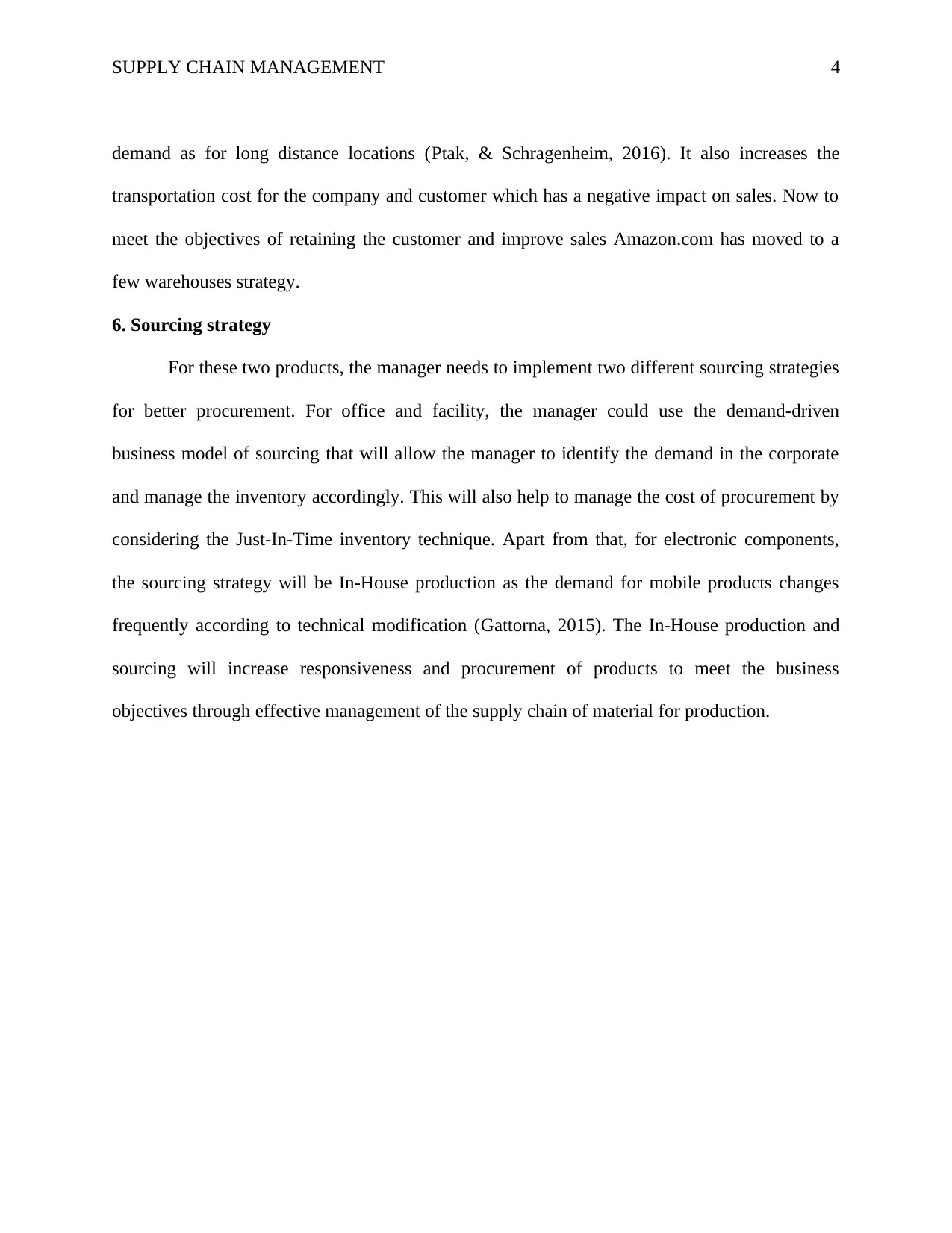
SUPPLY CHAIN MANAGEMENT 4
demand as for long distance locations (Ptak, & Schragenheim, 2016). It also increases the
transportation cost for the company and customer which has a negative impact on sales. Now to
meet the objectives of retaining the customer and improve sales Amazon.com has moved to a
few warehouses strategy.
6. Sourcing strategy
For these two products, the manager needs to implement two different sourcing strategies
for better procurement. For office and facility, the manager could use the demand-driven
business model of sourcing that will allow the manager to identify the demand in the corporate
and manage the inventory accordingly. This will also help to manage the cost of procurement by
considering the Just-In-Time inventory technique. Apart from that, for electronic components,
the sourcing strategy will be In-House production as the demand for mobile products changes
frequently according to technical modification (Gattorna, 2015). The In-House production and
sourcing will increase responsiveness and procurement of products to meet the business
objectives through effective management of the supply chain of material for production.
demand as for long distance locations (Ptak, & Schragenheim, 2016). It also increases the
transportation cost for the company and customer which has a negative impact on sales. Now to
meet the objectives of retaining the customer and improve sales Amazon.com has moved to a
few warehouses strategy.
6. Sourcing strategy
For these two products, the manager needs to implement two different sourcing strategies
for better procurement. For office and facility, the manager could use the demand-driven
business model of sourcing that will allow the manager to identify the demand in the corporate
and manage the inventory accordingly. This will also help to manage the cost of procurement by
considering the Just-In-Time inventory technique. Apart from that, for electronic components,
the sourcing strategy will be In-House production as the demand for mobile products changes
frequently according to technical modification (Gattorna, 2015). The In-House production and
sourcing will increase responsiveness and procurement of products to meet the business
objectives through effective management of the supply chain of material for production.
Paraphrase This Document
Need a fresh take? Get an instant paraphrase of this document with our AI Paraphraser
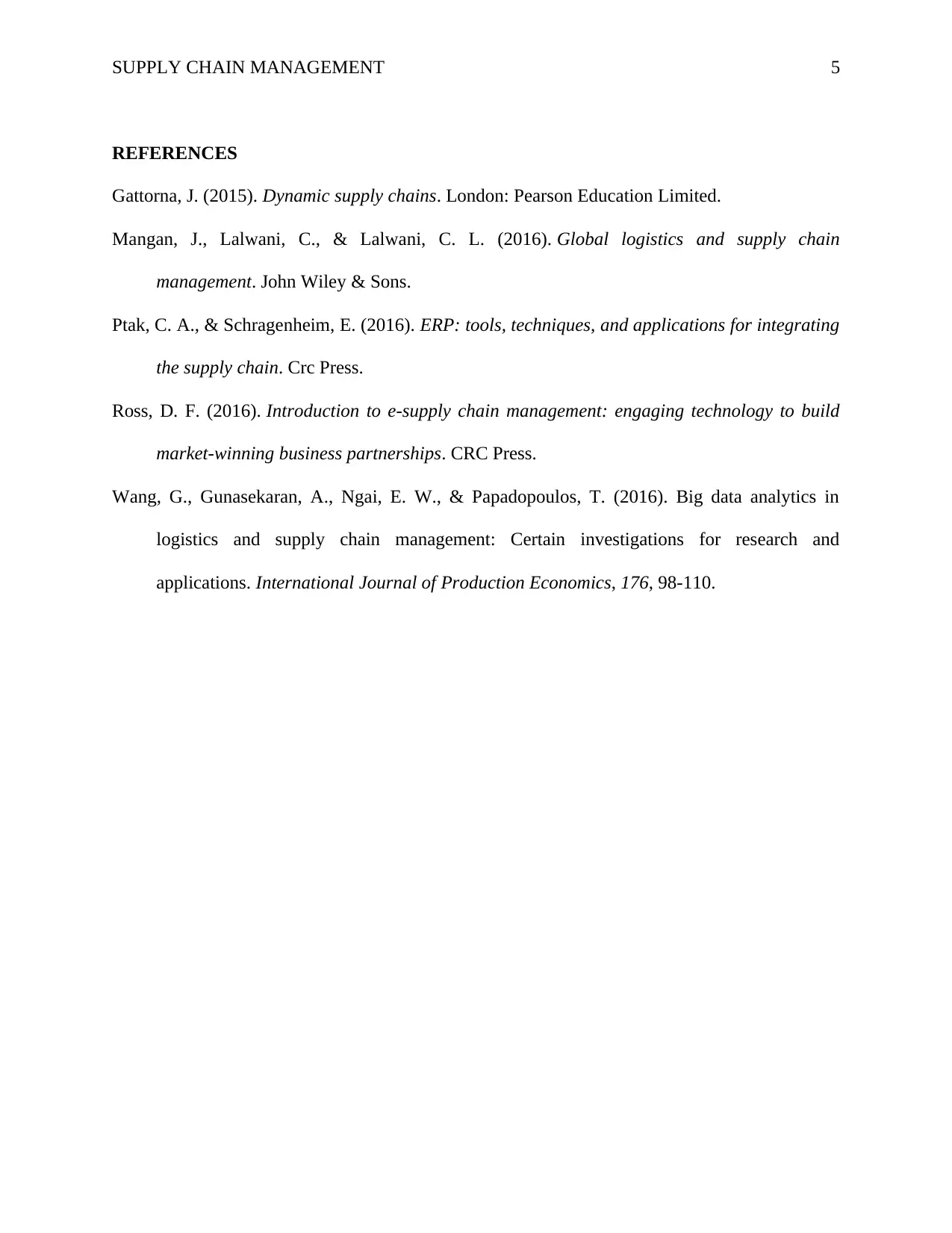
SUPPLY CHAIN MANAGEMENT 5
REFERENCES
Gattorna, J. (2015). Dynamic supply chains. London: Pearson Education Limited.
Mangan, J., Lalwani, C., & Lalwani, C. L. (2016). Global logistics and supply chain
management. John Wiley & Sons.
Ptak, C. A., & Schragenheim, E. (2016). ERP: tools, techniques, and applications for integrating
the supply chain. Crc Press.
Ross, D. F. (2016). Introduction to e-supply chain management: engaging technology to build
market-winning business partnerships. CRC Press.
Wang, G., Gunasekaran, A., Ngai, E. W., & Papadopoulos, T. (2016). Big data analytics in
logistics and supply chain management: Certain investigations for research and
applications. International Journal of Production Economics, 176, 98-110.
REFERENCES
Gattorna, J. (2015). Dynamic supply chains. London: Pearson Education Limited.
Mangan, J., Lalwani, C., & Lalwani, C. L. (2016). Global logistics and supply chain
management. John Wiley & Sons.
Ptak, C. A., & Schragenheim, E. (2016). ERP: tools, techniques, and applications for integrating
the supply chain. Crc Press.
Ross, D. F. (2016). Introduction to e-supply chain management: engaging technology to build
market-winning business partnerships. CRC Press.
Wang, G., Gunasekaran, A., Ngai, E. W., & Papadopoulos, T. (2016). Big data analytics in
logistics and supply chain management: Certain investigations for research and
applications. International Journal of Production Economics, 176, 98-110.
1 out of 5
Related Documents
Your All-in-One AI-Powered Toolkit for Academic Success.
+13062052269
info@desklib.com
Available 24*7 on WhatsApp / Email
![[object Object]](/_next/static/media/star-bottom.7253800d.svg)
Unlock your academic potential
Copyright © 2020–2025 A2Z Services. All Rights Reserved. Developed and managed by ZUCOL.





